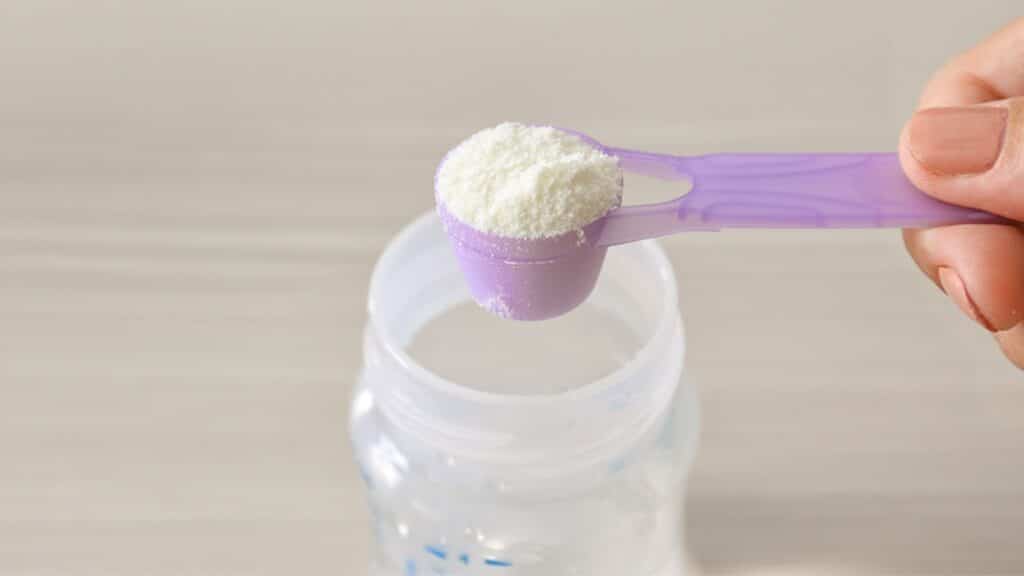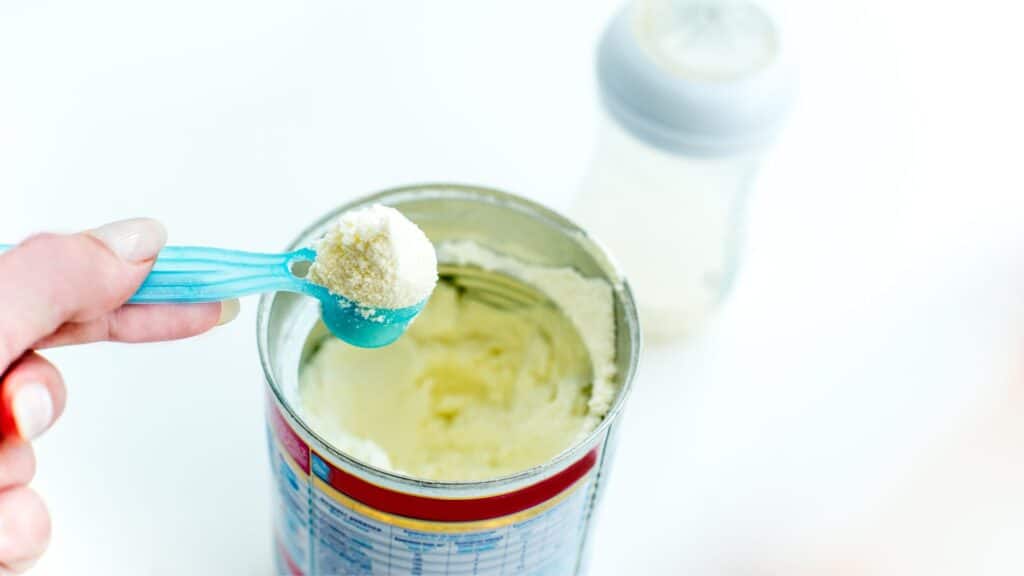Choosing the right baby formula for your little one can be overwhelming, especially if you are a first-time parent. With many options available, understanding the different types of baby formula and the role of baby formula ratios in infant nutrition is essential for making informed decisions about your baby’s health and well-being.
In this article, we will explore everything you need to know about baby formula ratios and the different types of baby formula to help you make the best choice for your baby.

What Are Baby Formula Ratios and Why Do They Matter?
Baby formula ratios refer to the specific proportions of ingredients in a given baby formula. These ratios can vary based on the type of infant nutrition you’re seeking and your baby’s individual needs. For instance, if your child has an allergy or intolerance to lactose or gluten, it is crucial to remove these ingredients from their diet to avoid digestive issues and other health complications later in life.
When preparing formula with hot water, it’s important to know the correct ratios to ensure your baby receives the right nutrients. If you’re uncertain about the kind of infant nutrition your child requires, or if you’re beginning to make homemade baby food, understanding how these ratios function is essential before deciding which foods are safe and suitable for your baby. By thoroughly comprehending baby formula ratios, you’ll be better equipped to make informed choices in providing the best nutrition for your little one.
Types of Baby Formula Ratios
There are three types of baby formula ratios:
- 1:1 ratio
- 2:1 ratio
- 3:1 ratio
The first number in each ratio represents the amount of protein in your baby’s diet, while the second represents fat. The higher the number, the more calories your baby gets from fat. For example, if you have a 1-month-old who needs 24 ounces (720 ml) per day and you choose a 2 oz/30 ml bottle with 20% milkfat, then this will provide around 200 calories per day–the same amount as if you were feeding them with a 1 oz/15 ml bottle containing 10% milkfat but less than half as much fat!
The Role of Baby Formula Ratios in Infant Nutrition
The first step to understanding how infant formula ratios, particularly in prepared formula, affect the growth and development of infants is to comprehend the significance of these numbers. The term “ratio” refers to the proportion of one nutrient in comparison to another, such as protein: fat or carbohydrate: protein. For instance, when you see a label that indicates a 20:25 ratio, it means there are 20 grams (g) of protein per 100 g serving size and 25 g of fat per 100 g serving size.
Utilizing proper infant formula and prepared formula not only supports healthy growth and development during infancy but also contributes to a robust immune system later in life. This becomes a critical factor when it’s time for children to receive their vaccinations.

Understanding the Different Types of Baby Formula
Navigating through the world of baby formula can be overwhelming for new parents. With a vast range of options available, it’s vital to comprehend the distinctions between powdered formula, ready-to-feed formula, and other infant formula products to make an informed decision tailored to your baby’s health and nutritional requirements.
The Basic Components of Baby Formula
Before diving into the different types of baby formulas, it’s essential to know their basic components, including carbohydrates, proteins, fats, and essential vitamins and minerals. These nutrients are vital for an infant’s growth and development.
- Carbohydrates: Carbohydrates are the primary source of energy for babies. Lactose, a natural sugar in breast milk, is the most common carbohydrate in baby formula. Some formulas may contain other carbohydrates like maltodextrin or corn syrup solids.
- Proteins: Proteins are crucial for building and repairing tissues and provide the building blocks for enzymes and hormones. Baby formulas contain either whey or casein proteins, or a combination of both, derived from cow’s milk.
- Fats: Fats are essential for brain development, hormone production, and overall growth. Baby formulas contain vegetable oils to provide the necessary fatty acids.
The Different Types of Baby Formula
- Cow’s Milk-Based Formula: The most common type of baby formula, cow’s milk-based formulas are made from cow’s milk proteins modified to be more digestible for infants. They are suitable for most babies who do not have a cow’s milk allergy or lactose intolerance.
- Soy-Based Formula: Soy-based formulas are a popular alternative for infants with a cow’s milk allergy or lactose intolerance. They are made from soy protein and often contain glucose or sucrose as a carbohydrate source.
- Hydrolyzed Protein Formula: Designed for babies with allergies or difficulty digesting cow’s milk or soy proteins, hydrolyzed formulas contain proteins broken down into smaller, easier-to-digest particles.
- Lactose-Free Formula: These formulas cater to babies with lactose intolerance or galactosemia, a rare genetic disorder that prevents the proper metabolism of lactose. Lactose-free formulas use alternative carbohydrate sources like corn syrup solids or sucrose.
- Specialized Formula: Some babies may require specialized formulas due to specific medical conditions, such as premature birth, reflux, or metabolic disorders. Consult your pediatrician to determine the most appropriate formula for your baby.
Powdered Formula vs. Ready-to-Feed Formula
When it comes to powdered infant formula and ready-to-feed formula, parents should consider the differences in convenience, storage, and cost. Powdered formula requires mixing with water, while ready-to-feed formula comes pre-mixed, offering greater ease for busy parents. However, powdered infant formula tends to be more cost-effective and has a longer shelf life compared to ready-to-feed options. Ultimately, the choice depends on the family’s unique needs and preferences.
When selecting a baby formula, consider your baby’s age, nutritional needs, and any allergies or intolerances they may have. It’s essential to consult your pediatrician, who can guide you in making the best choice for your baby’s health and well-being.

The Science of Baby Formula Ratios: How They Affect Your Baby’s Health
The ratios of macronutrients in baby formula, specifically proteins, fats, and carbohydrates, play a crucial role in a baby’s growth, development, and overall health. These nutrients provide the essential building blocks for a baby’s body, supporting the development of its brain, bones, muscles, and immune system.
Protein is vital for cell growth and repair, while fats provide energy and aid nutrient absorption. Carbohydrates, on the other hand, serve as the primary energy source for the body. The ideal ratio of these macronutrients in the baby formula should resemble that of breast milk, which contains about 1:3:7 protein, fat, and carbohydrate, respectively. However, each baby is unique, and their needs may vary slightly.
Selecting the Ideal Baby Formula Ratio for Your Little One
Picking the perfect baby formula ratio for your infant requires taking into account their age, weight, and unique dietary necessities. Here are some valuable tips to guide you in making a well-informed choice:
Consult your pediatrician: They can provide a recommendation on the most appropriate formula considering your baby’s needs and growth patterns.
Safely prepare formula: Ensure you follow the manufacturer’s instructions when mixing the formula to guarantee the correct ratio and consistency, reducing the risk of overfeeding or undernourishing your baby.
Read the label: Scrutinize the macronutrient ratios and any additional ingredients, like vitamins, minerals, or probiotics, which might positively impact your baby’s well-being.
Milk sugar and formula bottle: Be mindful of the milk sugar content in the formula and the quality of the formula bottle, as they can influence your baby’s feeding experience and overall health.
Take your baby’s age into account: As babies grow, their nutritional demands evolve. Ensure you select a formula that is age-appropriate and tailored to meet the distinct needs of your baby’s developmental stage.
Feeding your baby: Monitor your baby’s feeding habits and any potential reactions, such as allergies or sensitivities, to ensure the chosen formula is suitable for their specific nutritional requirements.

Common Concerns About Baby Formula Ratios: Debunking Myths and Misconceptions
As parents navigate the world of baby formula ratios, it’s natural to encounter misconceptions and concerns. To help put your mind at ease, we’ve gathered some of the most common myths and misconceptions about baby formula ratios and provided evidence-based answers to frequently asked questions.
Myth 1: The baby formula is inferior to breast milk.
Fact: While breast milk is the ideal source of nutrition for most babies, baby formulas are designed to closely mimic the nutritional profile of breast milk. Formulas provide necessary nutrients for your baby’s growth and development; formula feeding may be the best or only option for some families. It’s essential to choose a high-quality formula and consult your pediatrician to meet your baby’s nutritional needs.
Myth 2: More protein in the formula is always better.
Fact: It’s necessary to strike a balance regarding protein content in baby formula. Too much protein can strain your baby’s kidneys and lead to unnecessary weight gain. Choosing a formula with an appropriate protein content for your baby’s age and weight is crucial. Your pediatrician can help guide you in selecting the right formula.
Myth 3: Generic formulas are less nutritious than brand-name formulas.
Fact: Generic and brand-name formulas are subject to the same strict regulations and must meet the same nutritional standards set by regulatory bodies like the FDA. In many cases, generic formulas provide the same nutritional value as their brand-name counterparts at a lower cost. Choosing a formula from a reputable manufacturer, whether generic or brand-name, is essential.
Myth 4: You should never switch baby formulas.
Fact: Sometimes, it may be necessary to switch baby formulas due to dietary needs, allergies, or other concerns. If your baby is experiencing discomfort or not thriving on a particular formula, consult your pediatrician about alternative options. It may take some trial and error to find the perfect formula for your baby, and switching formulas under the guidance of a healthcare professional is perfectly acceptable.
Myth 5: You can “eyeball” the formula-to-water ratio.
Fact: Following the manufacturer’s instructions when mixing baby formula is crucial to ensure your baby receives the appropriate balance of nutrients. Too much water can dilute the formula and lead to undernourishment, while too little water can cause dehydration and strain your baby’s kidneys. Always use the recommended ratio and an excellent measuring scoop to ensure accurate mixing.
Parents can make informed decisions about their baby’s nutrition by addressing these common concerns and misconceptions about baby formula ratios. It’s essential to consult with a healthcare professional when making changes to your baby’s feeding routine and choose a high-quality formula that meets your baby’s specific needs.

Tips for Preparing and Storing Baby Formula Safely
Navigating the world of formula feeding can be daunting, but understanding the essentials of safely preparing and storing baby formula is crucial for your baby’s health. Here are some key tips to help you confidently feed your baby:
Prioritize Hygiene:
Always wash your hands thoroughly before handling formula bottles, mixing formula, or dealing with feeding equipment.
Follow the Guidelines:
Adhere to the manufacturer’s instructions for mixing formula and measuring the correct water-to-powder ratio to ensure your baby receives the right balance of nutrients.
Choose Safe Water Sources:
Opt for boiled tap water or bottled water without added fluoride when preparing your baby’s formula.
Skip the Microwave:
To prevent uneven heating and potential burns from hot spots, avoid microwaving formula bottles. Instead, warm the baby bottle in a container of hot water.
Store with Care:
Keep prepared formula in the refrigerator for up to 24 hours, and always discard any unused portions after each feeding to maintain freshness.
Keep Equipment Clean:
Regularly clean and sterilize all feeding equipment, such as baby bottles and nipples, to prevent harmful bacteria growth.
By mastering this formula feeding basics and recognizing the importance of human breast milk as an alternative, you’ll ensure that your baby receives the optimal nutrition they need for healthy growth and development. Whether you choose formula feeding, human milk, or a combination of both, being well-informed will help you confidently care for your little one.

Conclusion
In conclusion, understanding baby formula ratios is crucial for parents to make well-informed decisions about their infant’s nutrition and overall well-being. There are various baby formula ratios, such as 1:1, 2:1, and 3:1, with the first number representing protein and the second representing fat. Adequate nutrition during infancy promotes healthy growth, development, and a robust immune system later in life.
Several types of baby formulas are available, including cow’s milk-based, soy-based, hydrolyzed protein, lactose-free, and specialized formulas. When selecting a formula, consider your baby’s age, nutritional requirements, and any allergies or intolerances they may have. Always consult your pediatrician to ensure you make the best choice for your baby’s health and well-being.
We’d love to hear from you! Have a question? Let us know in the comments.



